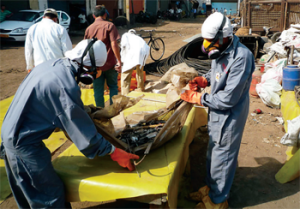
An Indian emergency response team identifies and removes contaminated objects after losing control of an irradiator. Courtesy: 1540 Magazine.
Miles Pomper
Aaron Gluck
July 29, 2015
The following is an excerpt of an article that was published in 1540 Compass Magazine, Issue 9, Summer 2015.
On April 13, 2015, several truck drivers parked at a grocery store in Tabasco, Mexico, and decided to leave their ruck unattended. Upon their return, they realized their cargo– a container carrying iridium-192 (Ir-192) that was used for industrial radiography– was missing. Fortunately, the thieves appear not to have realized what they had stolen and left the container carrying iridium-192 on the side of the road, where the Mexican authorities recovered it. Although this incident and several other similar thefts that occurred in Mexico in the past several years have not led to a catastrophic event, they have reinforced concerns regarding the security of high-risk radiological sources used in civilian applications. These thefts, when combined with the financial and sociological costs associated with the notorious 1987 accident in Goiania, Brazil, illustrate how an individual or group with malicious intent could cause significant harm.
A meaningful way to reduce the risk of radiological terrorism would be to remove the main ingredient for such an attack by replacing high-risk radiological materials with appropriate alternatives that use less dangerous or non-radionuclide materials or mechanisms. Ideally, adequate security measures for high-risk radiological materials would effectively counter risk. However, the ideal security environment that properly protects all high-risk radiological sources in civilian applications may not be achievable due to the sheer number of sources, facilities lacking resources […] and individual levels of appreciation for security culture. […] […] By examining the potential for replacing high-risk radiological material, specifically with cesium chloride (CsCl or Cs-137) in blood irradiators, a road map can be drawn and used for other high-risk radiological materials. […]
Read the full article on p. 41 of 1540 Compass Magazine.
